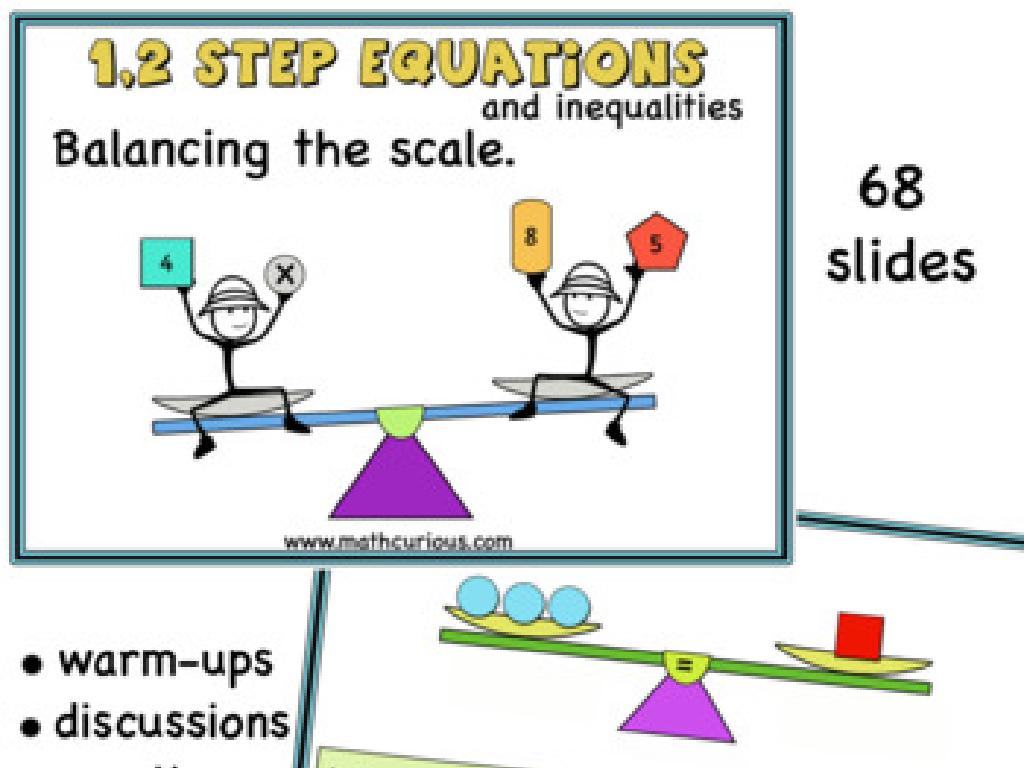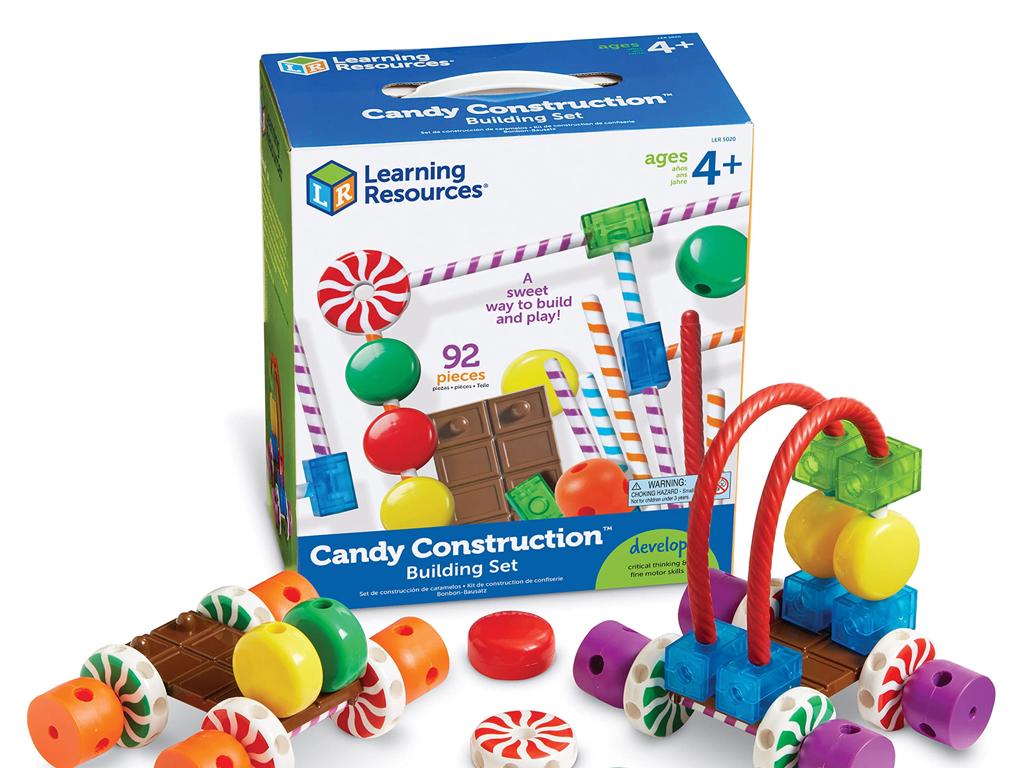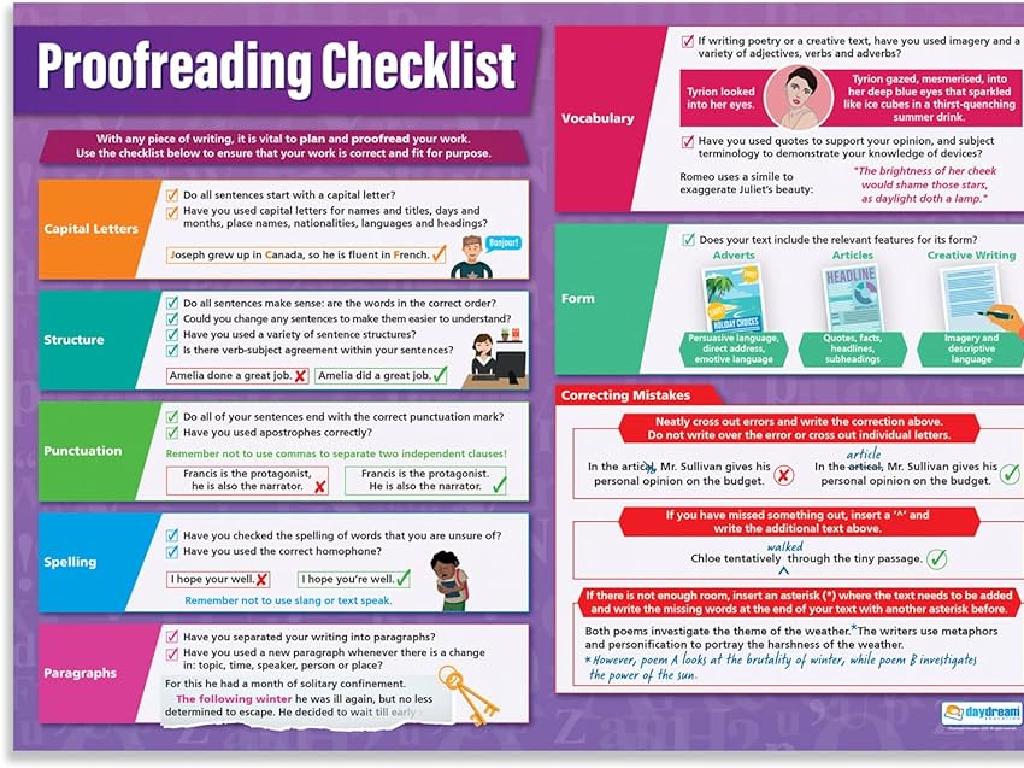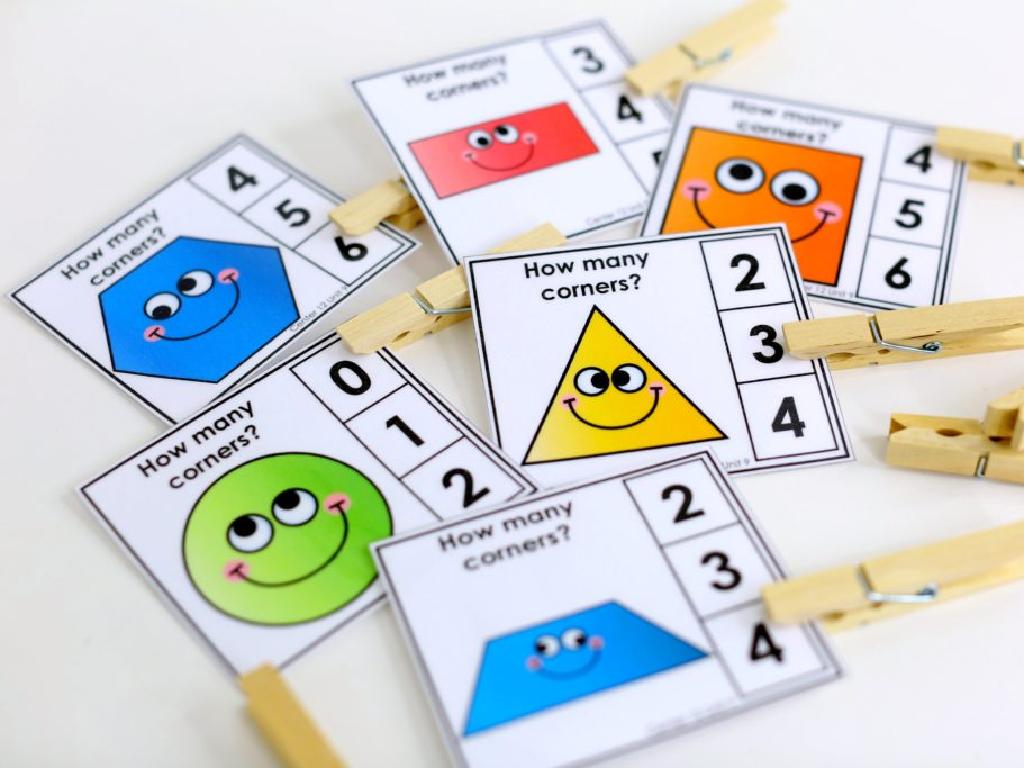Identify Common And Proper Nouns
Subject: Language arts
Grade: Fourth grade
Topic: Nouns
Please LOG IN to download the presentation. Access is available to registered users only.
View More Content
Welcome to Nouns: Common vs. Proper
– What are nouns?
– Nouns are words for people, places, things, or ideas
– Nouns are all around us
– Look around, every object and person is a noun!
– Today’s focus: Common & Proper Nouns
– Common nouns are general names, proper nouns are specific
– Understanding the difference
– Learn to categorize nouns correctly
|
Begin the lesson by explaining that nouns are the building blocks of language, representing people, places, things, or ideas. Emphasize that nouns are everywhere and part of our everyday communication. Introduce the concept of common and proper nouns, explaining that common nouns are general names for things (e.g., ‘city’, ‘dog’), while proper nouns name specific ones and are always capitalized (e.g., ‘New York’, ‘Buddy’). Use examples from the classroom and students’ experiences to illustrate the difference. Encourage students to look for nouns in their environment and in sentences, and to practice distinguishing between common and proper nouns.
Exploring Nouns
– Definition of a noun
– A noun is a word for any person, place, thing, or idea
– Nouns name people, places, things
– For example, ‘teacher’ (person), ‘park’ (place), ‘toy’ (thing)
– Examples: ‘dog’, ‘school’, ‘ball’
– ‘Dog’ refers to an animal, ‘school’ is a place of learning, ‘ball’ is an object for play
– Nouns can also name ideas
– Ideas like ‘happiness’ or ‘freedom’ are also nouns
|
This slide introduces the concept of nouns to fourth-grade students. Begin by explaining that nouns are words used to name everything around us. Use tangible examples like ‘dog’, ‘school’, and ‘ball’ to illustrate nouns that name people, places, and things. Then, introduce abstract nouns like ‘happiness’ to show that not all nouns can be touched or seen but can still be felt or experienced. Encourage students to look around the classroom or think about their favorite activities to come up with more examples of nouns. This will help them understand the broad application of nouns in language.
Exploring Common Nouns
– Common nouns name general items
– Like ‘city’, ‘movie’, ‘river’ – they’re everywhere!
– Not capitalized mid-sentence
– Examples: ‘dog’, ‘school’, ‘park’
– ‘I live in a city.’ ‘Let’s watch a movie.’ ‘The river is wide.’
– Use them in sentences
– Practice: Write a sentence with a common noun.
|
This slide introduces the concept of common nouns to fourth-grade students. Emphasize that common nouns are general names for people, places, things, or ideas and are not specific. They should understand that common nouns are not capitalized unless they’re at the beginning of a sentence or part of a title. Provide clear examples like ‘dog’, ‘school’, and ‘park’ to illustrate common nouns in everyday life. Encourage students to identify common nouns in their environment and use them in sentences, reinforcing their understanding through practice. The activity should involve students writing sentences with at least one common noun to apply what they’ve learned.
Exploring Proper Nouns
– Specific names are proper nouns
– Like ‘Samantha’, ‘Africa’, or ‘Coca-Cola’
– Begin with a capital letter
– No matter where in a sentence, they are capitalized
– Examples: ‘New York City’, ‘Titanic’, ‘Wednesday’
– ‘New York City’ is a place, ‘Titanic’ is a ship, ‘Wednesday’ is a day of the week
|
This slide introduces proper nouns to the students, emphasizing that they are specific names for particular people, places, things, or ideas and must always start with a capital letter, regardless of their position in a sentence. Use familiar examples such as ‘New York City’, ‘Titanic’, and ‘Wednesday’ to illustrate the concept. Encourage students to look around and identify proper nouns in the classroom, like the name of their school or a brand of a computer. This will help them understand the difference between common nouns and proper nouns. Have them practice by writing sentences using proper nouns they come across in their daily lives.
Common vs. Proper Nouns
– Common noun: general name
– Like ‘city’, ‘dog’, ‘school’
– Proper noun: specific name
– Like ‘Sarah’, ‘New York’, ‘Monday’
– ‘country’ vs. ‘Canada’
– Common: any nation, Proper: specific nation
– ‘company’ vs. ‘Google’
– Common: any business, Proper: specific business
|
This slide introduces the concept of common and proper nouns to fourth-grade students. A common noun is a general name for a person, place, or thing, like ‘city’, ‘dog’, or ‘school’. A proper noun is a specific name for a particular person, place, or thing, such as ‘Sarah’, ‘New York’, or ‘Monday’. Use examples like ‘country’ versus ‘Canada’ and ‘company’ versus ‘Google’ to illustrate the difference. Encourage students to identify more examples of common and proper nouns in their environment or from their reading. This will help them understand how to categorize nouns and use them correctly in sentences. The activity will involve students identifying nouns from a list and classifying them as common or proper.
Practice Time: Common or Proper Nouns?
– Listen to the noun I say
– Decide: Common or Proper?
– Remember, a common noun names any one of a class of person, place, or thing.
– Ready for a sorting game?
– Proper nouns name a specific one of these and begin with a capital letter.
– Let’s have fun learning!
|
This slide is designed to engage students in an interactive game to reinforce their understanding of common and proper nouns. As you say each noun, prompt students to think about whether the noun refers to a general item or a specific one. Remind them that common nouns are general names for people, places, or things (e.g., ‘city’, ‘dog’), while proper nouns are specific names and always start with a capital letter (e.g., ‘New York’, ‘Buddy’). Encourage participation and make the activity fun by congratulating correct answers and gently correcting any mistakes. You can use a mix of nouns related to the students’ own environment to make it more relatable. For example, ‘school’ (common) vs ‘Lincoln Elementary School’ (proper), ‘teacher’ (common) vs ‘Mrs. Smith’ (proper).
Let’s Review: Common vs. Proper Nouns
– What is a noun?
– A noun is a person, place, thing, or idea.
– Common vs. proper nouns
– Common nouns are general names, proper nouns are specific.
– Capitalizing proper nouns
– Proper nouns begin with a capital letter to show uniqueness.
– Significance of capital letters
|
This slide is aimed at reviewing the concept of nouns with a focus on the distinction between common and proper nouns. Begin by defining a noun to refresh the students’ memory. Then, explain the difference between common nouns (general names like ‘city’, ‘dog’) and proper nouns (specific names like ‘New York’, ‘Buddy’). Highlight that proper nouns always start with a capital letter to denote specific, unique entities. Emphasize the importance of capitalization in proper nouns as it helps in identifying the noun as a specific name and is a key rule in English grammar. Engage the class with examples and ask them to provide their own to solidify their understanding.
Class Activity: Noun Hunt
– Find 10 common nouns in class
– Find 10 proper nouns in class
– Share your nouns with a partner
– Exchange lists and see if you found similar nouns
– Discuss your categorizations
– Explain why one is common and the other is proper
|
This activity is designed to help students apply their knowledge of common and proper nouns in a fun and interactive way. Students will search the classroom for objects, people, and features that can be categorized as common nouns (general names like ‘desk’, ‘teacher’, ‘window’) and proper nouns (specific names like ‘Mrs. Smith’, ‘Mount Everest’, ‘January’). After compiling their lists, they will partner up to compare findings and discuss their reasoning, which reinforces the concept through peer learning. The teacher should circulate the room to assist and guide discussions, ensuring students understand the differences between common and proper nouns. Possible variations of the activity could include a timed challenge, noun scavenger hunt, or creating a classroom noun dictionary.





